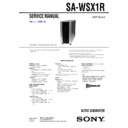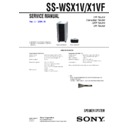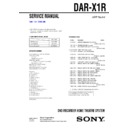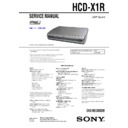Read Sony DAR-X1R / SA-WSX1R Service Manual online
SERVICE MANUAL
ACTIVE SUBWOOFER
SPECIFICATIONS
Ver. 1.1 2006.10
9-887-341-02
2006J05-1
© 2006.10
© 2006.10
Sony Corporation
Home Audio Division
Published by Sony Techno Create Corporation
Published by Sony Techno Create Corporation
AEP Model
SA-WSX1R
•
SA-WSX1R is the active subwoofer in DAR-X1R.
•
In this set, repair in the state of having connected with
HCD-X1R.
HCD-X1R.
•
This system incorporates with Dolby
*1
Digital and Dolby Pro Logic (II) adaptive
matrix surround decoder and the DTS
*2
Digital Surround System.
*1
Manufactured under license from Dolby Laboratories.
“Dolby”, “Pro Logic”, and the double-D symbol are trademarks of Dolby Laboratories.
“Dolby”, “Pro Logic”, and the double-D symbol are trademarks of Dolby Laboratories.
*2
Manufactured under license from Digital Theater Systems, Inc.
“DTS” and “DTS Digital Surround” are trademarks of Digital Theater Systems, Inc.
FM/AM tuner section
System:
PLL quartz-locked digital
synthesizer system
FM tuner:
Tuning range: 87.5
−
108.0 MHz (50kHz
step)
Aerial type: FM wire aerial
Aerial terminal: 75 ohms, unbalanced
Intermediate frequency: 10.7 MHz
Aerial type: FM wire aerial
Aerial terminal: 75 ohms, unbalanced
Intermediate frequency: 10.7 MHz
AM tuner:
Tuning range: 531
−
1,602 kHz
Aerial type: AM loop aerial
Intermediate frequency: 450 kHz
Intermediate frequency: 450 kHz
AUDIO POWER SPECIFICATION
Amplifier section
Amplifier section
Front
Power output (rated):
70 W + 70 W (4 ohms, 1 kHz, 1% THD)
RMS output power (reference):
80 W + 80 W (4 ohms, 1 kHz, 10%
THD)
THD)
Front surround
*
Power output (rated):
70 W + 70 W (4 ohms, 1 kHz, 1% THD)
RMS output power (reference):
80 W + 80 W (4 ohms, 1 kHz, 10%
THD)
THD)
Subwoofer
Power output (rated):
70 W + 70 W (4 ohms, 100 Hz, 1%
THD)
THD)
RMS output power (reference):
80 W + 80 W (4 ohms, 100 Hz, 10%
THD)
THD)
* Depending on the sound field settings and the source,
there may be no sound output.
Speakers
Subwoofer:
Speaker system: Bass reflex, magnetically
shielded
Speaker unit: 150 mm cone type (mica
reinforced cellular diaphragm)
shielded
Speaker unit: 150 mm cone type (mica
reinforced cellular diaphragm)
×
2
Rated impedance: 4 ohms
Dimensions (approx.): 205
Dimensions (approx.): 205
×
440
×
510 mm
(w/h/d) incl. projecting parts
Mass (approx.): 14 kg
Mass (approx.): 14 kg
Power requirements:
230 V AC, 50/60 Hz
Power consumption:
On: 110 W
Standby: 0.3 W
Standby: 0.3 W
Design and specifications are subject to change
without notice.
without notice.
•
JIG
When disassembling the set, use the
following jig (for speaker removal).
Part No.: J-2501-238-A JIG FOR
SPEAKER REMOVAL
When disassembling the set, use the
following jig (for speaker removal).
Part No.: J-2501-238-A JIG FOR
SPEAKER REMOVAL
2
SA-WSX1R
Notes on chip component replacement
•
Never reuse a disconnected chip component.
•
Notice that the minus side of a tantalum capacitor may be
damaged by heat.
SAFETY-RELATED COMPONENT WARNING!!
COMPONENTS IDENTIFIED BY MARK
0
OR DOTTED LINE
WITH MARK
0
ON THE SCHEMATIC DIAGRAMS AND IN
THE PARTS LIST ARE CRITICAL TO SAFE OPERATION.
REPLACE THESE COMPONENTS WITH SONY PARTS WHOSE
PART NUMBERS APPEAR AS SHOWN IN THIS MANUAL OR
IN SUPPLEMENTS PUBLISHED BY SONY.
REPLACE THESE COMPONENTS WITH SONY PARTS WHOSE
PART NUMBERS APPEAR AS SHOWN IN THIS MANUAL OR
IN SUPPLEMENTS PUBLISHED BY SONY.
TABLE OF CONTENTS
1.
SERVICING NOTES
...............................................
2
2.
GENERAL
...................................................................
5
3.
DISASSEMBLY
3-1.
Disassembly Flow ...........................................................
6
3-2.
Front Panel Assy ..............................................................
7
3-3.
DC Fan (M3000) .............................................................
8
3-4.
AMP Box Assy ................................................................
8
3-5.
SPK Out Board ................................................................
9
3-6.
TUNER (FM/AM) (TM10SCE), DSP Board ..................
9
3-7.
LF Board .......................................................................... 10
3-8.
Power Board .................................................................... 10
3-9.
AMP Board ...................................................................... 11
4.
DIAGRAMS
4-1.
Block Diagram – MAIN Section – .................................. 13
4-2.
Block Diagram – AMP Section – .................................... 14
4-3.
Block Diagram – POWER SUPPLY Section – ............... 15
4-4.
Printed Wiring Boards – DSP Section – .......................... 17
4-5.
Schematic Diagram – DSP Section (1/4) – ..................... 18
4-6.
Schematic Diagram – DSP Section (2/4) – ..................... 19
4-7.
Schematic Diagram – DSP Section (3/4) – ..................... 20
4-8.
Schematic Diagram – DSP Section (4/4) – ..................... 21
4-9.
Schematic Diagram – AMP Board (1/2) – ...................... 22
4-10. Schematic Diagram – AMP Board (2/2) – ...................... 23
4-11. Printed Wiring Board – AMP Board – ............................ 24
4-12. Printed Wiring Board – SPK OUT Board – .................... 25
4-13. Schematic Diagram – SPK OUT Board – ....................... 25
4-14. Printed Wiring Boards – POWER SUPPLY Section – .... 26
4-15. Schematic Diagram – POWER SUPPLY Section – ........ 27
4-11. Printed Wiring Board – AMP Board – ............................ 24
4-12. Printed Wiring Board – SPK OUT Board – .................... 25
4-13. Schematic Diagram – SPK OUT Board – ....................... 25
4-14. Printed Wiring Boards – POWER SUPPLY Section – .... 26
4-15. Schematic Diagram – POWER SUPPLY Section – ........ 27
5.
EXPLODED VIEWS
5-1.
Cabinet Section ................................................................ 39
5-2.
AMP Box Section ............................................................ 40
6.
ELECTRICAL PARTS LIST
............................... 41
UNLEADED SOLDER
Boards requiring use of unleaded solder are printed with the lead-
free mark (LF) indicating the solder contains no lead.
(Caution: Some printed circuit boards may not come printed with
free mark (LF) indicating the solder contains no lead.
(Caution: Some printed circuit boards may not come printed with
the lead free mark due to their particular size)
: LEAD FREE MARK
Unleaded solder has the following characteristics.
•
Unleaded solder melts at a temperature about 40
°
C higher
than ordinary solder.
Ordinary soldering irons can be used but the iron tip has to be
applied to the solder joint for a slightly longer time.
Soldering irons using a temperature regulator should be set to
about 350
°
C.
Caution: The printed pattern (copper foil) may peel away if
the heated tip is applied for too long, so be careful!
•
Strong viscosity
Unleaded solder is more viscou-s (sticky, less prone to flow)
Unleaded solder is more viscou-s (sticky, less prone to flow)
than ordinary solder so use caution not to let solder bridges
occur such as on IC pins, etc.
occur such as on IC pins, etc.
•
Usable with ordinary solder
It is best to use only unleaded solder but unleaded solder may
It is best to use only unleaded solder but unleaded solder may
also be added to ordinary solder.
SECTION 1
SERVICING NOTES
3
SA-WSX1R
NOTE OF HANDLING THE POWER BOARD
Connect the resistor (800
Ω
/2W) to discharge as shown in the figure below before handling the POWER board after turning the power off.
– POWER Board (Conductor Side) –
C908
C804
CN801
1
4
Connect either one.
NOTE OF HANDLING THE AMP BOARD
Connect the resistor (800
Ω
/2W) to discharge as shown in the figure below before handling the AMP board after turning the power off.
– AMP Board (Conductor Side) –
C3516
CN3003
4
1
Connect either one.
4
SA-WSX1R
AMP/DSP/LF/POWER/SPK OUT BOARDS SERVICE POSITION
– COMPONENT SIDE –
– CONDUCTOR SIDE –
LF board
power cord
power cord
SPK OUT board
POWER board
Take out the whole AMP box and check all boards.
Please take out from an AMP box and check all boards.
AMP board
DSP board
LF board
SPK OUT board
POWER board
AMP board
DSP board




